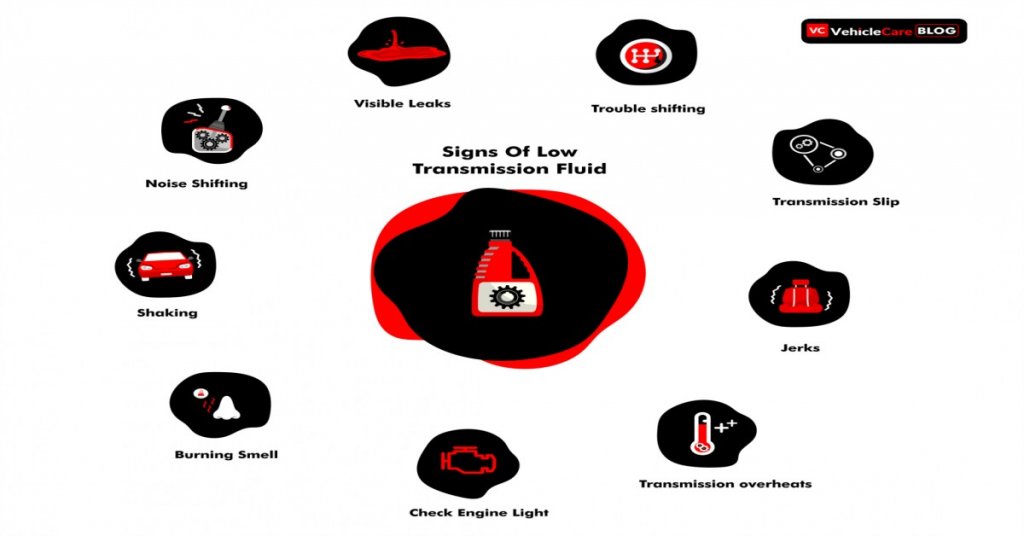Whether you own a manual or an automatic vehicle, the seamless operation of transmission requires a lubricating agent.
Just like the rotating components in a combustion engine use motor oil to lubricate and cool down its operations, the transmission in your vehicle uses its own kind of fluid.
Transfluing fluid works similar to engine oil in that it travels over the transmission to minimize friction of moving parts and reduce mechanical stress by dissipating heat.
With optimal levels maintained, driving is effortless (at least in an automatic transmission) but if your gear oil levels start to go low, you could experience a myriad of issues. Here are the signs you might notice if you are low on transmission fluid.
Table of Contents
Signs Of Low Transmission Fluid –

Visible Leaks
The appearance of transmission fluid is easy to identify with its distinct, bright red tone and thinner consistency than motor oil. It is usually contained within the transmission pan from where it is circulated around the system. But you could also find the liquid underneath the car if there’s a leak. Transmission fluid leaks can occur in multiple ways. Depending on how and where the fluid is leaking from, the amount can vary. One of the most common causes of a leak is a bad installation. If in times past, you attempted to change your transmission oil, there could be a chance, you missed to bolt the transmission pan firmly.
While it may not result in a leak immediately, it can lead to one later down the line. There are various other areas you could check to find a leak, that includes, chapped transmission lines, cracked transmission pump, broken transmission seals, and one chipped cooler hose.
Trouble or Delay Shifting Gears
A sufficient amount of transmission fluid is required to maintain the hydraulic pressure for the seamless transition of gears. Transmission shifts depend on hydraulic pressure created by the gear oil. Without enough hydraulic force, the clutch will not easily engage. If you constantly find gear shifts to be delayed or irregular, a low transmission fluid could possibly be the cause. You can test the delay time by simply shifting into reverse or drive. If the transmission takes few seconds to actually kick in and make the shift, you can confirm a problem with the transmission.
Jerks When Shifting Gears
While jerkiness and hard shifting can be attributed to a few different components, old and low hydraulic fluid seems to affect a seamless transmission quite commonly. Slight Jolts when shifting gears or even minor pushbacks can be an indication that your gear oil needs replacement.
Hard shifts from fluid issues typically occur when the bad gear oil gets in between the clutch pedal mechanism and creates excess friction that causes grabbing. When you shift gears make sure the clutch pedal actuation is smooth. Occasional shudders can easily turn into abrupt jerks later down the line if not treated carefully which can create unsafe circumstances for you and potentially ruin your transmission.
Shaking
One of the more uncommon symptoms of being low transmission fluid is a shaky and rough drive. This can happen when your transmission fluid has gone critically low and you might even see the check engine light come on.
If you feel your car shaking when you accelerate it could be a sign that you’re low on gear oil. And though the problem might be caused by insufficient lubrication, inspecting for a leak should be the right course of action as an abrupt and rapid depletion cannot occur on its own. Further, continuing to drive with a leak can cause irreparable damage to the transmission and result in hefty repairs.
Noise When Shifting Gear
There is some level of faint noise when you put your car in gear. It is a minimal sound from the clutch engagement that isn’t quite audible when at high speeds or cruising on a busy road. But if the noises coming from your gearbox are rather loud, it can spell serious trouble for the transmission.
One prime reason for transmission noises is bad transmission fluid. If you’re low on transmission fluid or have been driving on a contaminated liquid it could affect the clutch bearing and also prove detrimental to other components in the transmission. Having the gear oil replaced can help to allay such symptoms of low transmission fluid almost instantaneously. however, if the sounds persist, a more serious cause for such an issue can be an improper clutch setting or bad transmission mount.
Transmission Overheats
Apart from delivering the hydraulic pressure and lubricating the moving parts, the transmission fluid is also needed to cool down the transmission and maintain optimal temperatures for its proper functioning. The fluid travels over the transmission to absorb and dissipate heat as it cycles through the transmission coolers. It is carried through the oil cooler hose to the transmission cooler where it transmits the collected heat. It is then routed back into the system to start the process again.
When the transmission fluid is low, the dispersion of liquid along the entire system is not sufficient and consistent, which leads to improper cooling of the moving parts. While the cooler may be effectively taking out the heat from the fluid, a cut back in the actual coolant leads to a limited reach in cooling the system.
Burning Smell
Another common sign of low transmission fluid is a burning smell. This primarily happens due to the overheating of the transmission system. The heat produced by under lubricated parts burns the fluid around it. Though the transmission can also overheat due to an old cooler, failing cooler hose, or just bad driving habits, fluid problems are the most common cause. If your transmission fluid does not appear to be low but you still observe transmission problems including overheating issues, it could be due to bad or a dirty transmission fluid. The old and abrasive liquid cannot help with effective cooling and the gunk collected over time can be caught between the moving parts resulting in increased friction and thus heat in the system. Moreover, if your transmission is putting out more heat than usual it will accelerate the wear on the fluid and on the system as well.
Transmission Slip
Have your gear shifts been feeling a little out of sync lately? A transmission slip in an automatic vehicle occurs when the speed response is not commensurate with the gear shift. That is, you may notice the tachometer go up as you accelerate but the speedometer might not increase with the same force and consistency, producing a slippage effect. The vehicle may not accelerate and even slow down while you wait for the throttle response. Gear slippage is a condition that generally occurs with age and excessive wear and tear, although other possible reasons for the slip can include reduced hydraulic pressure. A leakage in the transmission fluid can accelerate the wear rate of the transmission parts and cause the gear sets to not engage properly. If you notice the slippage to not go away with a gear oil change, having the vehicle inspected should be the next step as driving with a transmission problem can be quite dangerous.
Check Engine Light
Lastly, the check engine light is another good indicator for low transmission fluid. Check engine light is designed to provide deeper insights into the system. It may not just indicate a depleted trans fluid but also point to a host of other transmission problems. An overheating transmission, fluid leak, failing transmission pressure sensor, as well as a deeper mechanical issue, all can trigger the engine light to come on.
Conclusion
There are a number of different things that can cause problems in your transmission and it can easy to get lost with all the signs and symptoms when you don’t exactly know what’s going on within. The key here is to look for the few different symptoms in conjunction with each other rather than checking them off individually. That way you can be the most thorough in your diagnosis and assess if are low on transmission fluid or have some other transmission issue that needs to be tended with. In any case, a gear oil change, which Ideally should be every 50000 miles or the interval stated in your owner’s manual.












